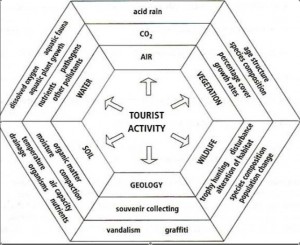 Source: K. Godfrey and J. Clarke, The Tourism Development Handbook (London: Thompson Learning, 2000), p. 31.
Source: K. Godfrey and J. Clarke, The Tourism Development Handbook (London: Thompson Learning, 2000), p. 31.
This chart here taken from “Global Trends in Coastal Tourism” prepared by the Center for Eco-Tourism and Sustainable development shows in detail many of the most prominent effects of tourism on an area. Road development is not specifically mentioned but facilitates all of these by providing access to the tourist. The outcomes all tend to be negative such as “acid rain, or vandalism” and give the impression that tourism is essentially bad for everything in a region except for the economy.


